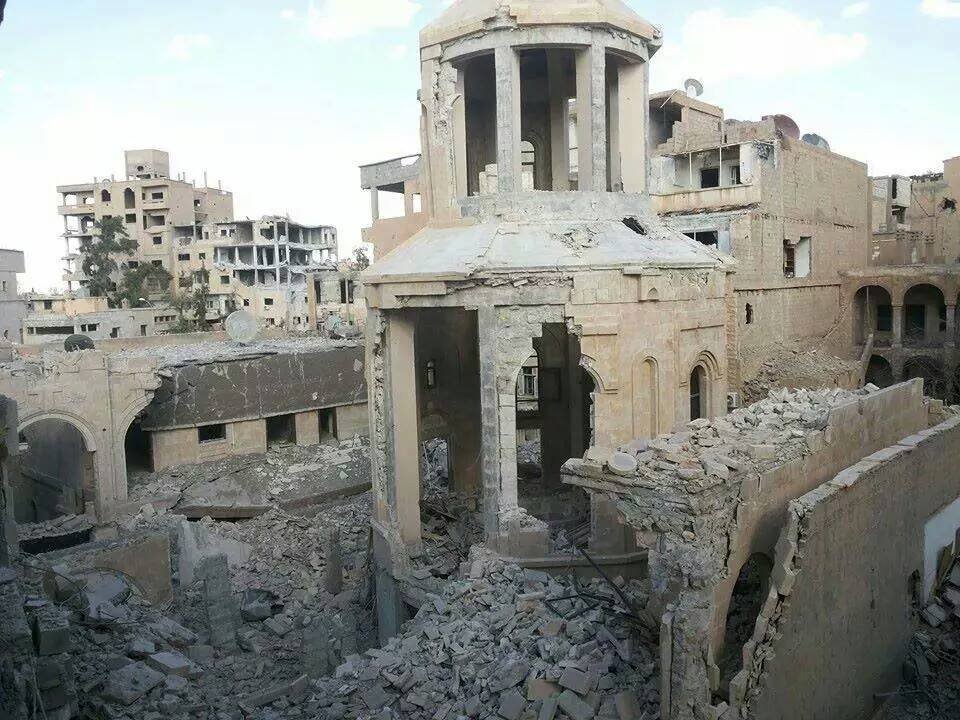The destruction of the Armenian Genocide Memorial Church in Der Zor
Special for the Armenian Weekly
By Rupen Janbazian
“If the road to Auschwitz was a ‘twisted path’, the path to Der Zor was positively torturous.” In his book The Dark Side of Democracy: Explaining Ethnic Cleansing, this is how sociologist Michael Mann describes the Syrian Desert, which would eventually become the final resting place for so many victims of the Armenian Genocide.

I had heard the name of the desert growing up and its utterance was always accompanied by sorrow, grief and distress. I remember the classic line: “If you go to Der Zor, you will see that fragments of Armenian bones still protrude the earth’s crust…”
It was all abstract to me. Living thousands of miles away, Syria and its deserts were a distant, intangible place. All that changed when a close friend of mine went on a summer trip to the Middle East with his family. We must have been about twelve or thirteen at the time. I didn’t really care where he was going; the fact that we would be apart for the summer was devastating, so everything else became secondary. Upon his return late that summer, he told me about visiting family in Lebanon and Syria, about the touristic sites they had visited and the delicious food they had indulged in. He also told me about their trip to Der Zor and how they had visited what he called a “church-museum sort of thing.” My first instinct was to ask about the fragments of bones, whose stories had traumatized us for years. To my surprise, he confirmed them.
He described how the remnants of the bones that had been dug out from the desert were displayed in the museum for everyone to see. I was captivated hearing him go on about this place and wished to see it for myself. Unfortunately, I never got the chance.
News reports about the destruction of the Armenian Genocide Memorial Church in Der Zor began emerging as Armenians around the world were celebrating the re-independence of their historic homeland. According to several sources in the Middle East, the Islamic State (also known as ISIS or ISIL) had rigged and dynamited the church erected in memory of the first genocide of the twentieth century.
I thought to myself, how could such a tragic event occur on a day that was regarded as one of the most significant and jubilant days in modern Armenian history? Was the curse of bad fortune really written on our foreheads as the Armenian proverb stated?
I rejected the claims. Although there was much outcry from the public, Armenia’s Foreign Ministry and even members of Congress and the U.S. Embassy in Armenia, there was no definite proof of the destruction; not a single picture, video clip or tangible piece of evidence in a conflict that had been unfolding in front of our eyes every day.
And then, images of the destruction had taken over my e-mail inbox and social media feeds. My doubts about the worst and optimism had been crushed almost instantaneously.
The Middle East is at a crossroads today. With the ever-changing political dynamic in the area, our understanding of the region is also changing. Terror groups like the Islamic State know no borders, and the loss of life over the past few months has been immense. While it is difficult to equate the death of innocent civilians to the loss of property, the destruction of memory can be instrumental in the continuation of genocides and other crimes against humanity.
The destruction of the Armenian Genocide Memorial Church can now be added to a long list of sites and monuments which have been lost since the Armenian Genocide. Although the circumstances in which these pillars of memory are erased may vary, it is imperative to realize the significance of losing them and what that may mean for the future.
I never got to see the memorial that was built on the site of my people’s Auschwitz. It is my hope however, that new sites are built to tell the story of our people’s loss and destruction.
The old saying holds true: “The writing on the forehead won’t be erased.” However, it is our duty as Armenians around the world to add to the writing. It is our duty to remind the world of what happened to our ancestors, in order to help ensure that similar atrocities do not take place in the future.


instate wengerocracy so you can watch the leader of the country you live in the entire time that person is leading your country. that is the only way to make sure law is above man in your country by making sure the leader of your country cant cover up unlawful behavior